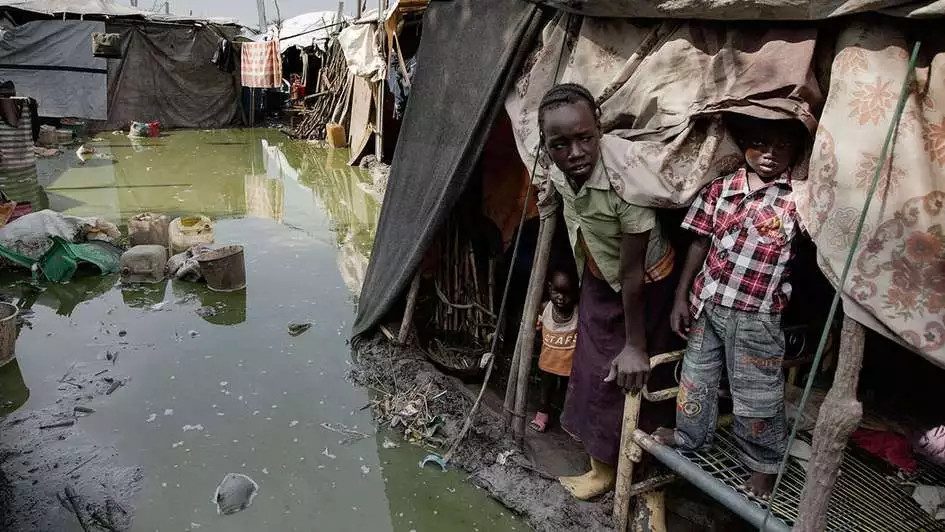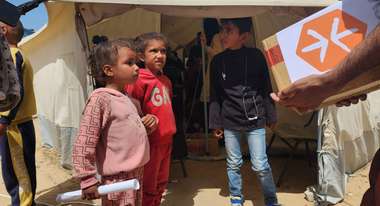Clay Huts and Slums – The Picture of Africa Drawn by German Mass Media
What do German media make people think about what moves Africa – which pictures are conveyed? Find out here.

What do the German media make us think about what moves Africa– which pictures are conveyed? To be more precise: I will show you which picture of Africa is drawn by the German mass media.
The shortened perspective on Africa in our eurocentric and ethnocentric media needs to be discussed in my point of view. It might even be an opportunity for players like Welthungerhilfe: more than ever, they can be the experts for the underrepresented subject matters of African nations and become a more important dialogue partners for German editorial departments?
We all agree that the set of problems is way too big to deal with it in a substantial way in that short spell. In addition, we all know there is no “Africa” as a homogeneous construction as much as there is no “Europe” as a big community of shared values and interests. Nevertheless, I will try to highlight four assumptions:
- The picture drawn of Africa is over-simplified.
- Illegal immigration to Europe is seen as a big threat.
- Wars and conflicts dominate media coverage.
- Diseases and famines –coverage oscillates between compassion, fear and resignation.
I will try to give a brief overview of the current results of research, refraining from personal comments at this point. The four theses reveal issues that German media coverage of Africa stress quite regularly. Doing this I take the perspective of a communication researcher, referring to academic references from my subject area with emphasis on results from the last five to ten years.
The Picture drawn of Africa is Over-Simplified
The picture painted of Africa in German media is rather homogeneous. Countries are rarely differentiated. Northern African countries and the “Arab Spring”, first of all in Egypt, are the sole exception. Africans south of the Sahara are still presented as poor and in need of help. Problems in African states are depicted as if the citizens cannot solve them by themselves. Attributes like “the poorest of the poorest” who live in “clay huts and slums” underline the dependency of Africans and their supposed state of underdevelopment (Beck et. al , 2012).
Since Germany is very enthusiastic about football we could see almost every match of the Africa Cup live on TV. The excesses during the semi-finals between Equatorial Guinea and Ghana were commented on TV similar to this.
It’s a pity that – again –we have to see pictures like these from an African football stadium. Barbaric acts of vandalism and unprovoked violent attacks.
As if such scenes are typical of Africa, and not – of Football…Even the football world cup 2010 in South Africa is considered as a missed opportunity of presenting Africa in a more differentiated way. The media denounced a whole continent as “irrational, archaic and repellent”, for example when they referred to superstitious beliefs of players, coaches and fans (Meier & Steinforth, 2010). Security risks were exaggerated by the media and attacks in Angola mentioned as reasons to boycott the world cup in South Africa–even though Cabinda and the nearest stadium are 2.800 km apart (Wachter, 2010).
Illegal Immigration is seen as a big threat
Though the number of immigrants from Africa takes up only a small percentage of all immigrants to Europe, they dominate the public discourse about illegal migration to Europe. This is for two reasons: On the one hand, we can consider a (subversive subliminal) hatred of foreigners, on the other hand the media report disasters happening in the Mediterranean Sea in compassionate way. The rather xenophobic frame expresses the fear of Europe being invaded by African immigrants. Immigrants are portrayed as a danger to the mid-European societies. Researchers are afraid that this type of media coverage fuels public discourse on how migration can be combatted in general. Even the quality press tends towards framing “migration as a threat” (Mbappou-Gleiß, 2008).
The media disregard the fact that the main share of migration from African states takes place within the African continent. Furthermore many immigrants to Europe are highly qualified.
Discourse analytical studies find that German media tend to reflect their government’s opinions and the European Union’s policy of defense and control. Nevertheless there is commentatorship that migration is seen as an opportunity (Assopgoum, 2012).
The more compassionate frame tries to point out the inhuman conditions under which refugees are brought to European boarders by criminal people smugglers. Last Thursday more than 300 refugees died at the coast of Lybia. Probably most of them came from the Sudan. We find intense media coverage, discussing political implications and reporting the fates of the people as accurately as possible. Here the problem of illegal migration via the Mediterranean Sea is seen as humanitarian problem that has to be solved by the European Union. Especially Italy suffers from inappropriate regulations for European boarders. Henc,e Italian media report much more about immigrants from Africa than German newspapers do. (Fohrn, 2009, S. 98)
Wars and Conflicts dominate media coverage
News factors like negativism, crime, corruption, crises and violence seem to be the reasons why German media emphasize wars and conflicts in Africa, although many African States live in peace (Sorge, 2014). For Western media it does not seem to be attractive to shine a light on political development in African regions. Foreign correspondents do no longer work on the spot but only come to Africa in case of present crises. Even the German quality weekly newspaper ZEIT closed its office for the sub-Sahara region. Disinterest in Africa by German media and society in general lead to a distorted image. The bad conditions under which correspondents have to work makes coverage more likely to be based on negativism (Mücke, 2009). So-called parachute correspondents often have a very euro-centered perspective on conflicts and locals are not able to get a word in edgeways.
Media coverage serves to perpetuate differences between “the West” and “the Others”, which means Africa or Africans. These classifications are seen as a product of the historically based balance of power. Wars in Africa are often conveyed as “black against black” whereas wars in Europe are never framed as white against white. Former findings show that from about 50 % (Mücke, 2009) to more than 80% (Dilg, 1999) of media coverage on Africa is classified as negative; and most of this deals with military conflicts.
Diseases and Famines–From Compassion to Fear to Resignation!?
In the end I will keep this point very short and give you a quote:
If we take our cue from the images in the mass media, then too often we learn everything about how an African dies, but nothing about how he lives. (Mankell, 2006)
During the last months, we have seen intense media coverage of the Ebola disease in Western Africa. Journalists have enunciated a lot of compassion. But nonetheless the media also focused on how and when the virus would reach Europe and Germany and whether we would be well-prepared in terms of medical equipment and knowledge.
Emphasizing diseases is typical of media coverage of Africa, since it supports the frame of an underdeveloped continent. This was also the case when AIDS was a major topic of the daily news. The repeated images of starvation and misery might be responsible for a desensitization of the public. In addition, this might even inhibit people’s willingness to support aid agencies. Furthermore the public might see development aid as useless if media coverage focuses on diseases and famines only (Sturmer, 2013). Thus, the media potentially activate a stereotyped dichotomy of the global society in merciful givers (here) and thankful takers (there).
Mainstream Discourse vs. Elite Discourse
Personally, I am convinced that the German media have a very limited view of Africa to offer. Moreover, I have given you a brief impression of what the mass media in general tell us about Africa, what they maintain we should think about the continent. The reasons for a rather pessimistic view of the continent are multifaceted. One of them is the work approach of the mass media. Others may be discussed today and tomorrow.
To be fair, I have to add that you can find very sophisticated articles, films, programs and blogs that tell us about growth, a spirit of optimism, a vivid arts and culture scene, literature, sports and everyday life in Africa; and there is a self-critical discourse about Europe’s neglected colonial history.
However, I would rather call all this an elite discourse that takes place in elite media or scientific journals and not in large radius mass media. The positively framed issues do by far not have the coverage that the points I have mentioned above do have. They exist, but the negative topics are the media mainstream. I am looking forward to opening up new vistas.
This text is the written version of my key note held during the “Searchers Unlimited –Think Tank in Addis Abeba” on 16th February, 2015. It is not a complete review of the scientific discourse but in outlines it represents the discourse.



